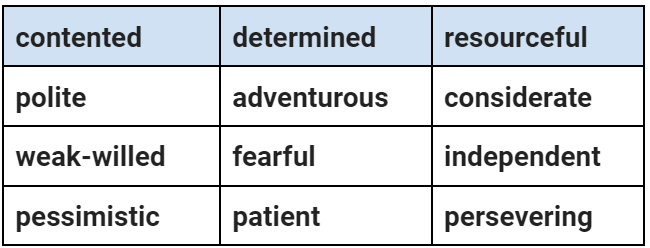NCERT Solutions for Class 9 English Beehive Chapter 7 - Reach for the Top

Thinking about the Text (Page 87)
I. Answer these questions in one or two sentences each. (The paragraph numbers within brackets provide clues to the answers.)
Q.1. Why was the ‘holy man’ who gave Santosh’s mother his blessings surprised? (1)Ans. The ‘holy man’ was surprised because he had assumed that Santosh’s mother wanted a son. But grandmother told him that they did not want a son.
Q.2. Give an example to show that even as a young girl, Santosh was not ready to accept anything unreasonable. (2)
Ans. Santosh, from the very beginning, lived life on her own terms. She was not content with the traditional way of life and was not ready to accept anything unreasonable. Where other girls wore traditional Indian dresses, Santosh preferred shorts.
Ans. Even though Santosh’s parents could afford to send their children to the best schools, she was sent to the local village school due to the prevailing custom in the family.
Ans. When she turned sixteen and was under pressure to get married, Santosh threatened her parents that she would never marry if she did not get a proper education. Therefore, she left home and got herself enrolled in a school in Delhi.
 Santosh Yadav Q.5. Why did Santosh’s parents agree to pay for her schooling in Delhi? What mental qualities of Santosh are brought into light by this incident? (4)
Santosh Yadav Q.5. Why did Santosh’s parents agree to pay for her schooling in Delhi? What mental qualities of Santosh are brought into light by this incident? (4)Ans. When Santosh's parents refused to pay for her education, she politely informed them of her plans to earn money by working part-time to pay her school fees. Then, her parents agreed to pay for her schooling in Delhi. This shows that Santosh was a mentally-strong girl and was determined to work very hard to get herself properly educated.
II. Answer each of these questions in a short paragraph (about 30 words). (Page 88)
Q.1. How did Santosh begin to climb mountains?
Ans. Santosh began climbing mountains after observing people ascending the Aravalli Hills from her hostel room. She discovered they were mountaineers and asked to join them. They agreed, encouraged her passion, and she later accompanied them on climbing expeditions.
Ans. During the Everest mission, Santosh showed immense concern for her fellow climbers. Though she was unsuccessful in saving the life of one of them, she did manage to save another climber through artificial respiration.
Ans. Santosh was a fervent environmentalist. Her concern for the environment is evident from the fact that she collected and brought down 500 kilograms of garbage from the Himalayas.
Ans. Santosh asserted that her feeling at the summit of the Everest was“indescribable”. Unfurling the Indian flag on the top of the world was a spiritual moment for her and she felt proud as an Indian.
Ans. When Santosh Yadav first scaled Mt Everest, she becamethe youngest woman in the world to achieve the feat. When she scaled Everest the second time, she became the only woman to have scaled it twice.
III. Complete the following statements.
(a) From her room in Kasturba Hostel, Santosh used to _________
(b) When she finished college, Santosh had to write a letter of apology to her father because of _________
(c) During the Everest expedition, her seniors in the team admired her _________ while _________endeared her to fellow climbers.
Ans.
(a) From her room in Kasturba Hostel, Santosh used to watch villagers going up the hill and suddenly vanish after a while.
(b) When she finished college, Santosh had to write a letter of apology to her father because she had got herself enrolled at Uttarkashi’s Nehru Institute of Mountaineering without his permission.
(c) During the Everest expedition, her seniors in the team admired her climbing skills, physical fitness, and mental strength while her concern for others and desire to work together with them endeared her to fellow climbers.
IV. Pick out words from the text that mean the same as the following words or expressions. (Look in the paragraphs indicated.)
(a) Took to be true without proof (1): _________
(b) Based on reason; sensible; reasonable (2): _________
(c) The usual way of doing things (3): _________
(d) A strong desire arising from within (5): _________
(e) The power to endure, without falling ill (7): _________
Ans.
(a) Took to be true without a proof (1): Assumed
(b) Based on reason; sensible; reasonable (2): Rational
(c) The usual way of doing things (3): Custom
(d) A strong desire arising from within (5): Urge
(e) The power to endure, without falling ill (7): Resistance
Thinking about the Text (Page 92)
Working in small groups of 4−5 students, go back over the two passages on Santosh Yadav and Maria Sharapova and complete the table given below with relevant phrases or sentences.

Ans.





Thinking about the Language (Page 92)
Look at the following sentences. They each have two clauses, or two parts each with their own subject and verb or verb phrase. Often, one part (italicised) tells us when or why something happened.
- I reached the marketwhen most of the shops had closed. (Tells us when I reached.)
- When Rahul Dravid walked back towards the pavilion, everyone stood up. (Tells us when everyone stood up.)
- The telephone rang and Ganga picked it up. (Tells us what happened next.)
- Gunjan has been with usever since the school began. (Tells us for how long he has been with us.)
I. Identify the two parts in the sentences below by underlining the part that gives us the information in brackets.
(a) Where other girls wore traditional Indian dresses, Santosh preferred shorts. (Contrasts her dress with that of others)
(b) She left home and got herself enrolled in a school in Delhi. (Tells us what happened after the first action.)
(c) She decided to fight the system when the right moment arrived. (Tells us when she was going to fight the system.)
(d) Little Maria had not yet celebrated her tenth birthday when she was packed off to train in the United States. (Tells us when Maria was sent to the U.S.)
Ans.
(a) Where other girls wore traditional Indian dresses, Santosh preferred shorts.
(b) She left home and got herself enrolled in a school in Delhi.
(c) She decided to fight the system when the right moment arrived.
(d) Little Maria had not yet celebrated her tenth birthday when she was packed off to train in the United States.
II. Now rewrite the pairs of sentences given below as one sentence. (Page 93)
(a) Grandfather told me about the old days. All books were printed on paper then.
(b) What do you do after you finish the book? Perhaps you just throw it away.
(c) He gave the little girl an apple. He took the computer apart.
(d) You have nothing. That makes you very determined.
(e) I never thought of quitting. I knew what I wanted.
Ans.
(a) Grandfather told me about the old days when all books were printed on paper.
(b) After finishing the book, perhaps you just throw it away.
(c) He gave the little girl an apple and took the computer apart.
(d) Having nothing makes you very determined.
(e) I never thought of quitting as I knew what I wanted.
II. Which of these words would you use to describe Santosh Yadav? Find reasons in the text to support your choices, and write a couple of paragraphs describing Santosh’s character. (Page 94)

Ans.
Santosh Yadav was determined, considerate, polite and hard working.She was a rebel who did not want to follow the traditional ways of living. She developed a remarkable resistance to cold and altitude that is required for mountaineering. She proved herself repeatedly because of her iron will, physical endurance and amazing mental toughness. She was a fervent environmentalist who brought 500 kgs of garbage from the Himalayas.
|
263 videos|1418 docs|124 tests
|
FAQs on NCERT Solutions for Class 9 English Beehive Chapter 7 - Reach for the Top
| 1. What is the main theme of the article "Reach for the Top"? |  |
| 2. Who are the key figures mentioned in the article, and what are their contributions? |  |
| 3. How does the article illustrate the concept of overcoming obstacles? |  |
| 4. What lessons can readers learn from "Reach for the Top"? |  |
| 5. How does the language used in the article enhance its impact? |  |

















